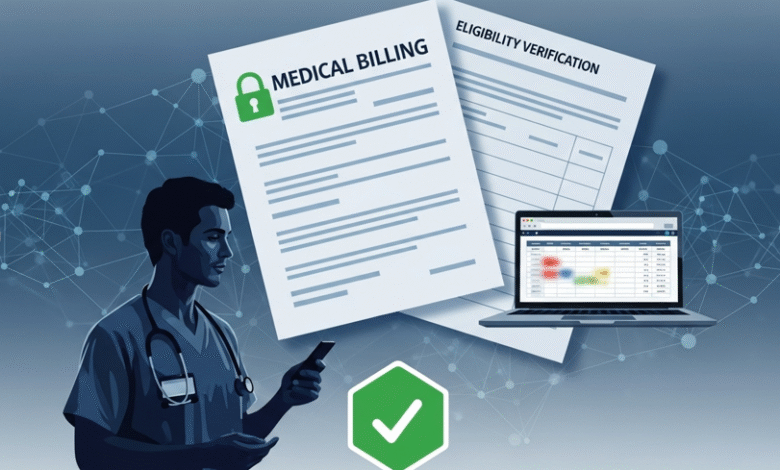HIPAA and Eligibility Verification: How to Stay Secure and Compliant in Medical Billing

In medical billing, everything begins with trust—trust that the information a patient shares will stay private, and trust that the billing process will be accurate and secure. That’s where HIPAA compliance and the eligibility verification process in medical billing come together.
Eligibility verification isn’t just an administrative step. It’s a critical checkpoint that determines whether services are billable and what coverage applies. But with every insurance lookup, phone call, and data entry, patient information moves through multiple systems—and that’s where compliance risks can sneak in.
Let’s look at how to keep your eligibility and benefits verification secure, accurate, and fully compliant with HIPAA standards, while also improving your revenue cycle efficiency.
Understanding HIPAA and Its Role in Medical Billing Compliance
The Health Insurance Portability and Accountability Act (HIPAA) protects the privacy and security of patient health information. It applies to all healthcare providers, billing teams, and anyone handling patient data.
For billing and verification teams, two main HIPAA rules matter most:
- The Privacy Rule: Defines how patient information can be used or shared.
- The Security Rule: Sets technical and administrative safeguards to protect electronic data.
In the eligibility verification process in medical billing, every detail you collect—from policy numbers and dates of birth to payer IDs—is considered Protected Health Information (PHI). This means even a minor oversight, like sending an unencrypted email or leaving a form on a desk, can count as a HIPAA violation.
The Importance of Eligibility Verification in Revenue Cycle Success
Eligibility verification happens at the very beginning of the revenue cycle, but it affects every stage after. If coverage details aren’t checked correctly, you risk claim rejections, delayed payments, and compliance issues.
The eligibility and benefits verification process in medical billing ensures that:
- Services provided are covered by the payer.
- Copay, deductible, and coinsurance details are accurate.
- Authorizations or referrals are confirmed before treatment.
A secure, accurate benefit verification in medical billing doesn’t just prevent denials—it helps maintain patient trust and regulatory compliance. When practices manage insurance eligibility verification effectively, both patients and payers recognize that they’re working with a professional, compliant operation.
Key Areas of Risk During Eligibility Verification
Even well-intentioned staff can create compliance risks when handling eligibility tasks. Let’s break down the most common ones:
1. Using unsecured communication methods
When insurance details are sent through personal email, chat apps, or shared spreadsheets, PHI is exposed. HIPAA requires all communication during eligibility verification in medical billing to happen through encrypted and authorized systems.
2. Local or unprotected data storage
Saving benefit verification data on desktops or unprotected drives leaves it vulnerable. Secure, role-based cloud systems are the safer choice.
3. Human error and poor data entry
A simple typo in an insurance ID or uploading the wrong patient file can lead to both denials and compliance violations.
4. Inconsistent staff training
Not every team member fully understands how privacy rules apply to their tasks. Without regular HIPAA and billing training, even experienced staff can make small but costly mistakes.
5. Lack of role-based access
When everyone in the office can open every patient’s record, it’s a clear compliance red flag. HIPAA expects access control based on job roles.
See also: How Round Shag Rugs Add Warmth to Cool Floors?
Steps to Keep Eligibility Verification Secure
Compliance doesn’t have to be complicated. Here are practical ways to protect patient data while maintaining an efficient verification workflow.
1. Use HIPAA-compliant billing software
Choose software that encrypts data, tracks user activity, and limits access to only those who need it. These tools make it easier to perform eligibility and benefits verification securely.
2. Follow the “minimum necessary” rule
Staff should access only the information required for the task. There’s no need to open full records if you’re only confirming policy status.
3. Train your team
Hold short, focused sessions on data handling, password security, and safe communication. Clear, practical examples help staff retain the rules better than lengthy lectures.
4. Encrypt everything
Whether you’re emailing, uploading, or saving, encryption should be standard. Even if data is intercepted, it remains unreadable without the key.
5. Regular audits and monitoring
Set up quarterly audits to review eligibility verification logs and data handling. This step helps identify small issues before they become violations.
The Financial Impact of Secure Verification
Staying HIPAA-compliant doesn’t just protect you from fines—it also improves billing outcomes. When your eligibility verification process in medical billing is accurate, your first-pass claim rate improves, AR days drop, and denials decrease.
In behavioral health and ABA billing services, for example, secure eligibility checks prevent coding errors and mismatched payer information, which are common reasons for claim rejections. A compliant workflow ensures that patient details move through verification, submission, and payment without unnecessary exposure or manual rework.
When compliance and accuracy go hand-in-hand, revenue grows and patient satisfaction improves.
Checklist for HIPAA-Compliant Eligibility Verification
These steps form the foundation of a secure and efficient eligibility and benefits verification process in medical billing.
How Automation Reduces Compliance Risks
Automation tools are transforming how clinics handle eligibility verification. Instead of manually calling payers or entering details into spreadsheets, automated systems pull coverage data in real time and update records securely.
This approach reduces human error, limits data exposure, and shortens turnaround time. More importantly, it provides an audit trail—proof that every verification was handled securely, which is a huge advantage during compliance reviews.
For clinics offering behavioral or therapy services, automated benefit verification in medical billing ensures that each session or CPT code is matched to the correct payer rule before claims are even submitted.
FAQs
1. What is HIPAA compliance in eligibility verification?
It means following federal privacy and security rules when accessing or sharing patient information during insurance verification. Every step—from collecting to storing data—must follow secure practices.
2. How is eligibility verification related to HIPAA?
Eligibility verification requires using patient details to confirm insurance coverage. Since this involves PHI, all actions must comply with HIPAA’s Privacy and Security Rules.
3. What are the common compliance mistakes in benefit verification?
Unencrypted communication, shared logins, saving data locally, and skipping staff training are among the most common mistakes that lead to HIPAA violations.
4. How can clinics improve the verification process?
Use automated, HIPAA-compliant tools, apply encryption, and train staff regularly. These steps improve accuracy and maintain data safety.
5. Does HIPAA compliance affect claim payments?
Yes. When your eligibility verification in medical billing is secure and accurate, it reduces errors and denials, which leads to faster reimbursements and better cash flow.
Conclusion
The eligibility verification process in medical billing is more than a routine step—it’s the backbone of clean claims and patient trust. Each time you verify coverage, you’re handling sensitive information that deserves the same care as clinical data.
By combining HIPAA compliance with clear internal policies, secure systems, and well-trained staff, clinics can streamline their eligibility and benefits verification while keeping patient data fully protected.
In the end, compliance isn’t just about avoiding penalties. It’s about showing patients—and payers—that your practice values integrity, security, and precision in every part of the billing process.
Because when eligibility verification is done right, everything else in medical billing follows smoothly.





